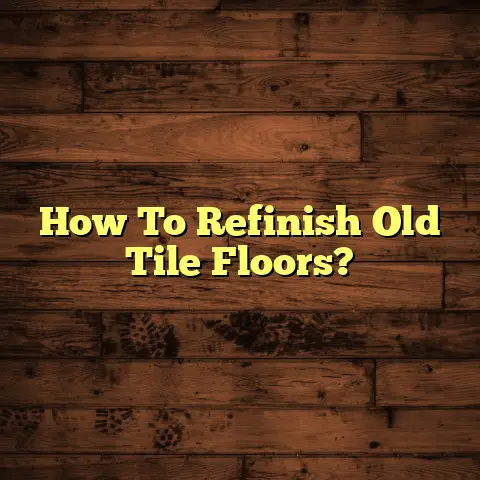Indoor-Outdoor Floor Tiles? (2 Costly Mistakes!)
Lately, I’ve noticed a huge surge in the popularity of indoor-outdoor floor tiles. And honestly, I get it. The idea of a seamless transition from your living room to your patio? Pure genius! Plus, the bold and stylish designs available now are seriously eye-catching.
But hold on a second. Before you jump headfirst into this trend, let me tell you about a couple of costly mistakes I’ve seen homeowners make time and time again. Trust me, avoiding these pitfalls can save you a ton of money and heartache down the road.
Section 1: The Allure of Bold Designs
Let’s be real – flooring isn’t just about functionality anymore. It’s a statement piece! And the current trend of bold designs in indoor-outdoor tiles is all about making a splash.
We’re talking geometric patterns that pop, vibrant colors that energize, and even natural stone looks that bring the outdoors in (and vice versa!). I’m seeing a lot of:
- Geometric patterns: Think hexagons, chevrons, and Moroccan-inspired designs.
- Vibrant colors: Blues, greens, and even bold reds are making their way onto patios and sunrooms.
- Large format tiles: Fewer grout lines, more impact.
- Natural stone imitations: Porcelain and ceramic tiles that mimic the look of travertine, slate, and marble.
These bold designs can truly transform a space, creating a striking visual impact that wows guests and makes your home feel more modern and inviting. I’ve seen it firsthand!
For example, I recently worked on a project where we used large-format porcelain tiles with a wood-look pattern to connect an indoor living room with an outdoor deck. The result? A seamless, stylish space that felt both cohesive and expansive. You can check out similar projects on sites like Houzz for inspiration.
The possibilities are endless, but it’s important to remember that with great design comes great responsibility. And that’s where those costly mistakes come in…
Section 2: Mistake #1 – Ignoring Material Suitability
Alright, let’s dive into the first major blunder I see all the time: choosing the wrong material for your indoor-outdoor tiles. This is a big one, folks.
Think about it. Your outdoor tiles are going to be exposed to the elements – rain, snow, sun, you name it. Indoor tiles? Not so much. So, you can’t just slap any old tile down and expect it to hold up.
Here’s a quick rundown of common materials and their pros and cons:
| Material | Advantages | Disadvantages | Best For |
|---|---|---|---|
| Ceramic | Affordable, wide variety of designs, relatively easy to install. | Less durable than porcelain, can be porous (especially unglazed), susceptible to cracking in freezing temperatures, lower slip resistance. | Indoor spaces, covered patios in mild climates. |
| Porcelain | Highly durable, water-resistant, frost-resistant, slip-resistant options available, wide variety of designs. | More expensive than ceramic, can be more difficult to install (requires specialized tools for cutting). | Indoor and outdoor spaces, including patios, decks, and pool areas. |
| Natural Stone | Beautiful, unique, adds value to your home. | Can be expensive, requires sealing and regular maintenance, some types are porous and susceptible to staining, can be slippery when wet. | High-end indoor and outdoor spaces, requires careful selection based on climate and usage. |
| Composite | Durable, weather-resistant, slip-resistant, often made from recycled materials. | Can be more expensive than ceramic or porcelain, may not have the same aesthetic appeal as natural stone or some porcelain options. | Decks, patios, pool areas, areas with high foot traffic. |
Data compiled from personal experience and industry resources like the Tile Council of North America (TCNA).
Slip Resistance: This is HUGE. You don’t want your guests (or yourself!) taking a tumble after a rain shower. Look for tiles with a high slip resistance rating (check the Dynamic Coefficient of Friction, or DCOF).
Durability: Outdoor tiles need to withstand foot traffic, furniture, and the occasional dropped grill spatula. Porcelain is generally more durable than ceramic.
Weather Resistance: If you live in an area with freezing temperatures, make sure your tiles are frost-resistant. Otherwise, they could crack and crumble over the winter.
I remember one particularly painful situation where a homeowner chose beautiful, but porous, travertine tiles for their outdoor patio in a region with harsh winters. Within a year, the tiles were cracked, stained, and looked like they’d been through a war. The cost to replace them? Let’s just say they learned a very expensive lesson about material suitability.
Don’t let that be you!
Section 3: Mistake #2 – Overlooking Installation and Maintenance Requirements
Okay, so you’ve chosen the perfect, weather-resistant, slip-resistant tiles. Great! But your work isn’t done yet. The second costly mistake I see homeowners make is underestimating the complexities of installation and maintenance.
Let me break it down:
Installation:
- Leveling: Your outdoor surface needs to be perfectly level to prevent water from pooling and causing problems.
- Substrate Preparation: The substrate (the surface underneath the tiles) needs to be properly prepared to ensure the tiles adhere correctly. This might involve adding a layer of concrete or a specialized membrane.
- Waterproofing: Especially important for patios and decks, proper waterproofing will prevent water damage to the structure underneath.
I cannot stress enough the importance of hiring a skilled professional for this. I know, I know, DIY projects can be tempting. But trust me, when it comes to tile installation, experience matters. I’ve seen DIY jobs that end up costing more in the long run because of mistakes that need to be corrected.
Maintenance:
Bold designs, while stunning, can sometimes require more upkeep. For example, tiles with intricate patterns might be harder to clean. Lighter colored tiles might show dirt and stains more easily.
- Sealing: Natural stone tiles need to be sealed regularly to protect them from staining.
- Cleaning: Use appropriate cleaning products to avoid damaging the tiles.
- Grout Maintenance: Grout can be a breeding ground for mold and mildew, so regular cleaning is essential.
I had a client who installed beautiful, light-colored porcelain tiles with a textured surface on their patio. They loved the look, but quickly realized that the textured surface trapped dirt and was difficult to clean. They ended up spending hours scrubbing the tiles every weekend, which definitely took the joy out of their new outdoor space.
Bottom line: Before you commit to a bold design, think about the long-term maintenance involved. Are you prepared to put in the effort to keep your tiles looking their best?
Section 4: Balancing Aesthetics with Functionality
This is where the rubber meets the road. It’s all about finding that sweet spot where beauty meets practicality.
Sure, that vibrant, patterned tile might look amazing in a magazine, but will it actually work in your space?
Here are some things to consider:
- Traffic: High-traffic areas require more durable tiles.
- Climate: Extreme weather conditions can impact the lifespan of your tiles.
- Safety: Slip resistance is crucial, especially around pools or in areas that get wet frequently.
- Sun Exposure: Darker colored tiles can get very hot in direct sunlight, making them uncomfortable to walk on.
I always tell my clients to think about how they actually use their outdoor space. Do they have kids or pets? Do they entertain frequently? These factors will influence the best tile choices.
For example, if you have a pool, you’ll want to choose tiles that are slip-resistant, water-resistant, and comfortable to walk on barefoot. A textured porcelain tile would be a great option.
If you have a high-traffic patio, you’ll want to choose a durable tile that can withstand a lot of wear and tear. A through-body porcelain tile (where the color goes all the way through the tile) would be a good choice because it won’t show scratches as easily.
Don’t let your desire for a bold design overshadow the practical considerations. A beautiful tile that’s not functional is ultimately a waste of money.
Section 5: The Future of Indoor-Outdoor Flooring
So, what’s on the horizon for indoor-outdoor flooring? I’m seeing some exciting trends emerging:
- New Materials: Manufacturers are constantly developing new materials that are more durable, weather-resistant, and sustainable.
- Larger Format Tiles: These tiles create a more seamless look and require less grout.
- Smart Technology: Some tiles are now being embedded with sensors that can detect leaks or changes in temperature.
- Sustainable Options: Recycled materials and eco-friendly manufacturing processes are becoming increasingly popular.
I believe that the future of indoor-outdoor flooring is all about combining style, functionality, and sustainability. As homeowners become more aware of the environmental impact of their choices, I expect to see a greater demand for eco-friendly flooring options.
My advice? Stay informed! Do your research, talk to professionals, and don’t be afraid to ask questions. The more you know, the better equipped you’ll be to make the right choices for your home.
Final Thoughts
Choosing indoor-outdoor floor tiles can be an exciting process. By taking the time to consider material suitability, installation requirements, and maintenance needs, you can avoid those costly mistakes and create a stunning, functional space that you’ll enjoy for years to come.
Remember, it’s all about balancing aesthetics with practicality. Don’t let your love for a bold design cloud your judgment. Choose wisely, and you’ll be rewarded with a beautiful and durable flooring solution that enhances your home’s value and your quality of life.
Happy tiling!





